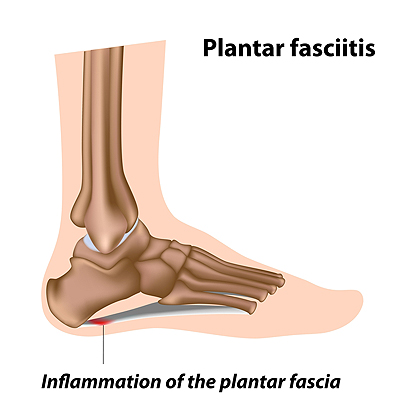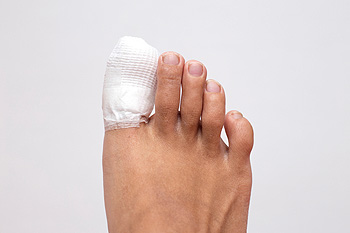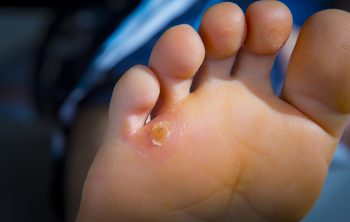Blog
Items filtered by date: August 2021
The Education of a Podiatrist
 The area of the body that podiatrists treat are the feet, and sometimes the ankle too. They are specialists that are qualified in correcting disorders of the feet, and are defined as foot specialists. Some podiatrists may choose to practice a specific form of podiatry, including sports medicine, pediatrics, or diabetic foot care. Mandatory education consists of obtaining a bachelor's degree, followed by completing a four year program in a podiatric medical school. Additionally, there are many states that require completing a two year residency program as this can provide hands on experience with various medical and surgery practices. If you are considering a career in podiatry, it is suggested that you consult with a podiatrist who can enlighten you on the daily procedures of podiatry.
The area of the body that podiatrists treat are the feet, and sometimes the ankle too. They are specialists that are qualified in correcting disorders of the feet, and are defined as foot specialists. Some podiatrists may choose to practice a specific form of podiatry, including sports medicine, pediatrics, or diabetic foot care. Mandatory education consists of obtaining a bachelor's degree, followed by completing a four year program in a podiatric medical school. Additionally, there are many states that require completing a two year residency program as this can provide hands on experience with various medical and surgery practices. If you are considering a career in podiatry, it is suggested that you consult with a podiatrist who can enlighten you on the daily procedures of podiatry.
If you are experiencing pain in the feet or ankles, don’t join the stubborn majority refusing treatment. Feel free to contact one of our doctors from Favor Foot Ankle Leg & Wound Center. Our doctors can provide the care you need to keep you pain-free and on your feet.
What Is a Podiatrist?
Someone would seek the care of a podiatrist if they have suffered a foot injury or have common foot ailments such as heal spurs, bunions, arch problems, deformities, ingrown toenails, corns, foot and ankle problems, etc.
Podiatric Treatment
A podiatrist will treat the problematic areas of the feet, ankle or lower leg by prescribing the following:
- Physical therapy
- Drugs
- Orthotic inserts or soles
- Surgery on lower extremity fractures
A common podiatric procedure a podiatrist will use is a scanner or force plate which will allow the podiatrist to know the designs of orthotics. Patients are then told to follow a series of tasks to complete the treatment. The computer will scan the foot a see which areas show weight distribution and pressure points. The podiatrist will read the analysis and then determine which treatment plans are available.
If you have any questions please feel free to contact our office located in South Amboy, NJ . We offer the newest diagnostic and treatment technologies for all your foot and ankle needs.
Using a Resistance Band to Stretch the Calves
 A resistance band is an elastic band typically used for stretching and strength training. If you are not particularly flexible, using a resistance band may be helpful in building flexibility and getting the full benefits of a stretch. A resistance band may be used to do a simple calf stretch. Sit on the floor with both legs straight out in front of you, then wrap the resistance band around the bottom of one foot. Holding one end of the band in each hand, pull the band toward you to flex your foot. Hold this stretch for 30 seconds, then switch sides and repeat on the other foot. For more information about how you can use a resistance band to stretch your feet and ankles, please consult with a podiatrist.
A resistance band is an elastic band typically used for stretching and strength training. If you are not particularly flexible, using a resistance band may be helpful in building flexibility and getting the full benefits of a stretch. A resistance band may be used to do a simple calf stretch. Sit on the floor with both legs straight out in front of you, then wrap the resistance band around the bottom of one foot. Holding one end of the band in each hand, pull the band toward you to flex your foot. Hold this stretch for 30 seconds, then switch sides and repeat on the other foot. For more information about how you can use a resistance band to stretch your feet and ankles, please consult with a podiatrist.
Stretching the feet is a great way to prevent injuries. If you have any concerns with your feet consult with one of our doctors from Favor Foot Ankle Leg & Wound Center. Our doctors will assess your condition and provide you with quality foot and ankle treatment.
Stretching the Feet
Stretching the muscles in the foot is an important part in any physical activity. Feet that are tight can lead to less flexibility and make you more prone to injury. One of the most common forms of foot pain, plantar fasciitis, can be stretched out to help ease the pain. Stretching can not only ease pain from plantar fasciitis but also prevent it as well. However, it is important to see a podiatrist first if stretching is right for you. Podiatrists can also recommend other ways to stretch your feet. Once you know whether stretching is right for you, here are some excellent stretches you can do.
- Using a foam roller or any cylindrical object (a water bottle or soda can will do), roll the object under your foot back and forth. You should also exert pressure on the object. Be sure to do this to both feet for a minute. Do this exercise three times each.
- Similar to the previous one, take a ball, such as a tennis ball, and roll it under your foot while seated and exert pressure on it.
- Grab a resistance band or towel and take a seat. If you are using a towel, fold it length wise. Next put either one between the ball of your foot and heel and pull with both hands on each side towards you. Hold this for 15 seconds and then switch feet. Do this three times for each foot.
- Finally hold your big toe while crossing one leg over the other. Pull the toe towards you and hold for 15 seconds. Once again do this three times per foot.
It is best to go easy when first stretching your foot and work your way up. If your foot starts hurting, stop exercising and ice and rest the foot. It is advised to then see a podiatrist for help.
If you have any questions, please feel free to contact our office located in South Amboy, NJ . We offer the newest diagnostic and treatment technologies for all your foot care needs.
Are You Suffering From Nerve Damage?
Traumatic Fractures vs. Stress Fractures in Toes
Broken toe bones can either be acute, traumatic fractures, or stress fractures. Traumatic fractures may occur suddenly due to a direct impact—such as stubbing your toe forcefully on a piece of furniture. The affected bone can crack and become displaced. You may hear a sound at the time of injury, feel pain at the point of impact, and see swelling and bruising the following day. You may also have a crooked or abnormal looking toe following the injury. Stress fractures are tiny cracks in bones that occur over time due to repetitive damage, often from playing sports or wearing poorly-fitted shoes. These types of fractures can cause pain during or after normal activity that may go away with rest, pain at the site of the fracture when it is touched, and swelling. Toe fractures that do not receive prompt and proper treatment may become chronically painful, deformed, or arthritic. If you suspect that you may have broken a toe, it is suggested that you see a podiatrist as soon as possible.
A broken toe can be very painful and lead to complications if not properly fixed. If you have any concerns about your feet, contact one of our doctors from Favor Foot Ankle Leg & Wound Center. Our doctors will treat your foot and ankle needs.
What to Know About a Broken Toe
Although most people try to avoid foot trauma such as banging, stubbing, or dropping heavy objects on their feet, the unfortunate fact is that it is a common occurrence. Given the fact that toes are positioned in front of the feet, they typically sustain the brunt of such trauma. When trauma occurs to a toe, the result can be a painful break (fracture).
Symptoms of a Broken Toe
- Throbbing pain
- Swelling
- Bruising on the skin and toenail
- The inability to move the toe
- Toe appears crooked or disfigured
- Tingling or numbness in the toe
Generally, it is best to stay off of the injured toe with the affected foot elevated.
Severe toe fractures may be treated with a splint, cast, and in some cases, minor surgery. Due to its position and the pressure it endures with daily activity, future complications can occur if the big toe is not properly treated.
If you have any questions please feel free to contact our office located in South Amboy, NJ . We offer the newest diagnostic and treatment technologies for all your foot and ankle needs.
What Are the Treatments for Foot Corns?
Corns are small lumps of thickened, hardened skin that occur due to friction or pressure on an area of the foot. They are most often located in between the toes, on top of the toes, or on the soles of the feet. Corns can be uncomfortable or even painful, but non-surgical treatment is usually successful. Most of these treatments work by off-loading, or taking the pressure off of, the corn. Your doctor may ask you to wear a padded corn sleeve over the corn if it is located on your toe. If the corn is located between the toes, you may be asked to wear a toe spacer between the affected toes to take pressure and friction off the corn. A corn donut, which is a padded, donut-shaped device, can be placed around the corn to off-load it. If it is associated with a large callus, your doctor can also trim the corn. If you suffer from painful foot corns, please schedule an appointment with a podiatrist near you.
If you have any concerns regarding your feet and ankles, contact one of our doctors of Favor Foot Ankle Leg & Wound Center. Our doctors will treat your foot and ankle needs.
Corns: What Are They? and How Do You Get Rid of Them?
Corns can be described as areas of the skin that have thickened to the point of becoming painful or irritating. They are often layers and layers of the skin that have become dry and rough, and are normally smaller than calluses.
Ways to Prevent Corns
There are many ways to get rid of painful corns such as wearing:
- Well-fitting socks
- Comfortable shoes that are not tight around your foot
- Shoes that offer support
Treating Corns
Treatment of corns involves removing the dead skin that has built up in the specific area of the foot. Consult with Our doctors to determine the best treatment option for your case of corns.
If you have any questions please feel free to contact our office located in South Amboy, NJ . We offer the newest diagnostic and treatment technologies for all your foot and ankle needs.
How Does Plantar Fasciitis Make the Heel Hurt?
 Plantar fasciitis is one of the most common reasons for heel pain. This condition occurs when the plantar fascia, a ligament that runs along the bottom of the foot and connects the heel bone to the toes, becomes inflamed. This is typically caused by tiny, repetitive trauma to the area during walking, running, standing for prolonged periods of time, or wearing ill-fitting shoes. The heel pain associated with plantar fasciitis is usually at its worst when you take your first few steps in the morning or after a long period of rest. This is thought to be because of the plantar fascia being slightly contracted while in bed or at rest. When you take your first few steps the ligament is stretched, which can bring about heel pain. If you are suffering from plantar fasciitis it is suggested that you seek the care of a podiatrist.
Plantar fasciitis is one of the most common reasons for heel pain. This condition occurs when the plantar fascia, a ligament that runs along the bottom of the foot and connects the heel bone to the toes, becomes inflamed. This is typically caused by tiny, repetitive trauma to the area during walking, running, standing for prolonged periods of time, or wearing ill-fitting shoes. The heel pain associated with plantar fasciitis is usually at its worst when you take your first few steps in the morning or after a long period of rest. This is thought to be because of the plantar fascia being slightly contracted while in bed or at rest. When you take your first few steps the ligament is stretched, which can bring about heel pain. If you are suffering from plantar fasciitis it is suggested that you seek the care of a podiatrist.
Plantar fasciitis is a common foot condition that is often caused by a strain injury. If you are experiencing heel pain or symptoms of plantar fasciitis, contact one of our doctors from Favor Foot Ankle Leg & Wound Center. Our doctors can provide the care you need to keep you pain-free and on your feet.
What Is Plantar Fasciitis?
Plantar fasciitis is one of the most common causes of heel pain. The plantar fascia is a ligament that connects your heel to the front of your foot. When this ligament becomes inflamed, plantar fasciitis is the result. If you have plantar fasciitis you will have a stabbing pain that usually occurs with your first steps in the morning. As the day progresses and you walk around more, this pain will start to disappear, but it will return after long periods of standing or sitting.
What Causes Plantar Fasciitis?
- Excessive running
- Having high arches in your feet
- Other foot issues such as flat feet
- Pregnancy (due to the sudden weight gain)
- Being on your feet very often
There are some risk factors that may make you more likely to develop plantar fasciitis compared to others. The condition most commonly affects adults between the ages of 40 and 60. It also tends to affect people who are obese because the extra pounds result in extra stress being placed on the plantar fascia.
Prevention
- Take good care of your feet – Wear shoes that have good arch support and heel cushioning.
- Maintain a healthy weight
- If you are a runner, alternate running with other sports that won’t cause heel pain
There are a variety of treatment options available for plantar fasciitis along with the pain that accompanies it. Additionally, physical therapy is a very important component in the treatment process. It is important that you meet with your podiatrist to determine which treatment option is best for you.
If you have any questions, please feel free to contact our office located in South Amboy, NJ . We offer the newest diagnostic and treatment technologies for all your foot care needs.
Blog Archives
- July 2025
- June 2025
- May 2025
- April 2025
- March 2025
- February 2025
- January 2025
- December 2024
- November 2024
- October 2024
- September 2024
- August 2024
- July 2024
- June 2024
- May 2024
- April 2024
- March 2024
- February 2024
- January 2024
- December 2023
- November 2023
- October 2023
- September 2023
- August 2023
- July 2023
- June 2023
- May 2023
- April 2023
- March 2023
- February 2023
- January 2023
- December 2022
- November 2022
- October 2022
- September 2022
- August 2022
- July 2022
- June 2022
- May 2022
- April 2022
- March 2022
- February 2022
- January 2022
- December 2021
- November 2021
- October 2021
- September 2021
- August 2021
- July 2021
- June 2021
- May 2021
- April 2021
- March 2021
- February 2021



